The wide Imperial Valley that straddles the Colorado River north of Yuma in
southwestern Arizona and southeastern California is the primary "salad
bowl" in the country, producing more than 175 different crops --
including more than 90% of the nation's leafy green vegetables from November through
March.
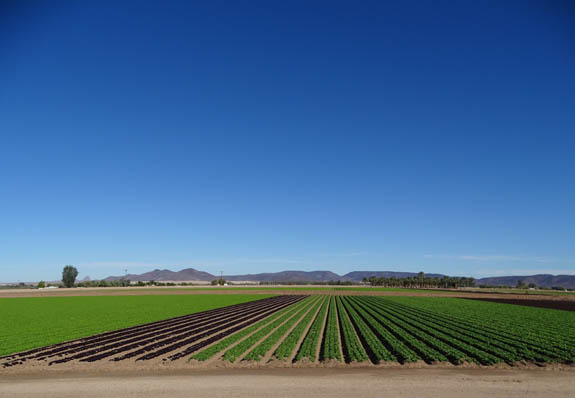
Large field with mixed salad greens
To the delight of the numerous human snowbirds who descend on this area
from the U.S. and Canada, it's also when we are here and can watch every
stage of the planting and harvesting process if we drive or ride our
bikes around the little farm roads..
Maybe it's just because I grew up on a farm and still have an avid
interest in gardening, but I think driving past all these farms is
satisfying even for "city folks" who haven't really thought much about
where their fruits and vegetables come from and how labor-intensive the
process is, even with some mechanization.
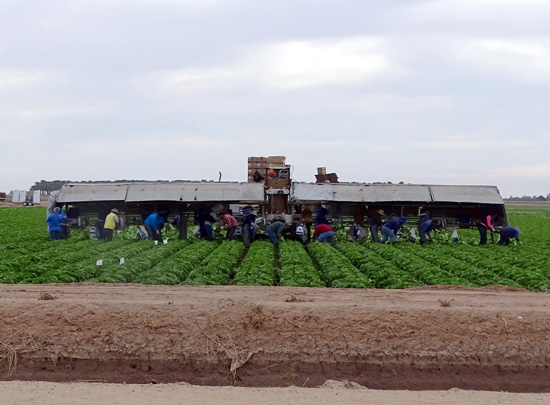
Above and below: hand-picking two veggie
crops
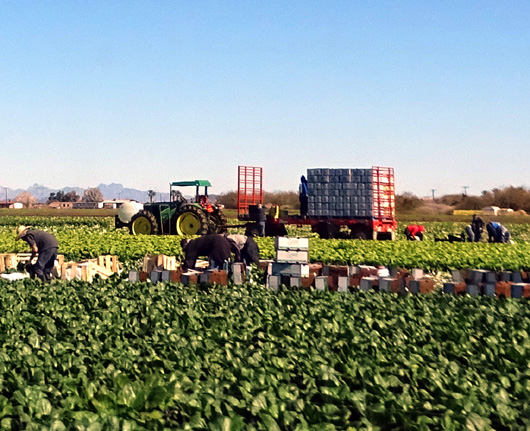
Fragile produce isn't like grain crops that can be
mostly mechanically planted and harvested. People still have to prep the
land, plant the seeds, set up the irrigation systems, prune and thin the
seedlings, if necessary, get the weeds out, harvest the crop by hand,
pack it appropriately so it isn't ruined, and transport it to market.
I find the whole process fascinating, and it's one of the things I like best
about spending the winter in the Yuma area.
There are large and small farmers' markets, locally-grown produce in
restaurants and grocery stores, hands-on farming lessons, "fields to
feast" tours at the University of Arizona research farm, the Yuma
Medjool Date Festival, and an annual Lettuce Days "feastival"
to celebrate the area's homegrown bounty.
THE SCENIC PASTORAL DRIVE TO YUMA
From our RV park at Yuma Proving Ground there are two main ways to
reach Yuma, each about 25 miles to the edge of the city.
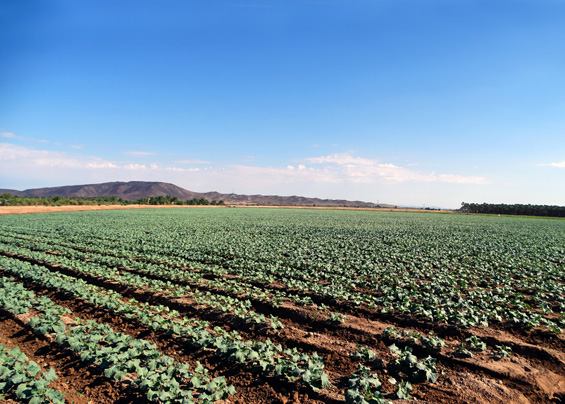
Most people choose to go the faster way -- east on Imperial Dam Road to US 95
and south on that wider highway to the Foothills on the eastern side of Yuma.
It passes a few farms but is mostly desert terrain.
We preferred
to go west on Imperial Dam Road, across the Colorado River, and zigazg
along narrow S24 through California past verdant produce farms and orchards
to the western side of the city where more of the stores and medical
facilities were located that we used.
But the main reason I wanted to go that way was to slowly drive past 20
miles of farms and orchards!
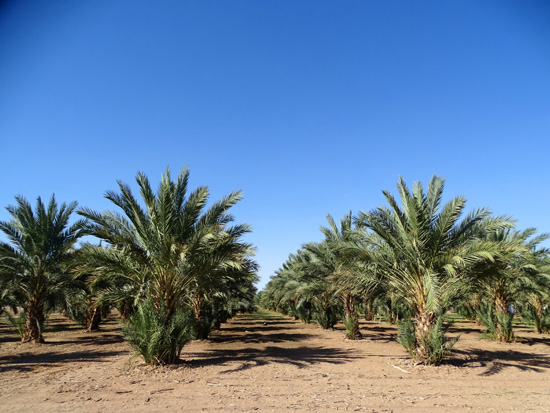
Medium-sized date trees
Oh, and did I mention that Imperial Date Gardens is on that route?
Their date shakes are to die for! We tried to limit ourselves to one
medium shake per week but it took a lot of control. The only time I felt
totally guilt-free eating one of those things was the day Jim and I both
rode our bikes 10 miles to the date store and back. I figured I burned
off enough calories in 20 miles to justify the calories.
I'll
have more about our personal tour of Imperial Date Gardens in a little
bit.
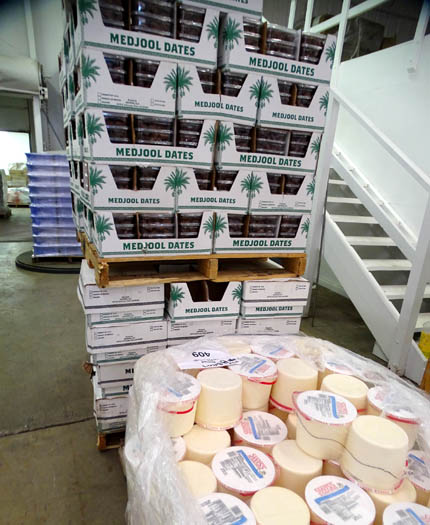
Dates and ice cream for shakes
in Imperial Date Gardens' warehouse
(the ice cream was in transit to one of the large
freezers; dates freeze well, too).
When we stayed at the Imperial Dam LTVA four years ago it was in
January to mid-March, still in prime growing season but after many of
the crops had been planted. Some greens, like lettuce, grow pretty fast
so we did see some turnover in those fields but many like broccoli and
cauliflower take longer so we didn't see them when they were seedlings.
This time we arrived on October 25, when many of the fields were
still bare and just being prepped for planting. It was interesting to
see the land being plowed and trenched and all the irrigation pipes
being laid out:
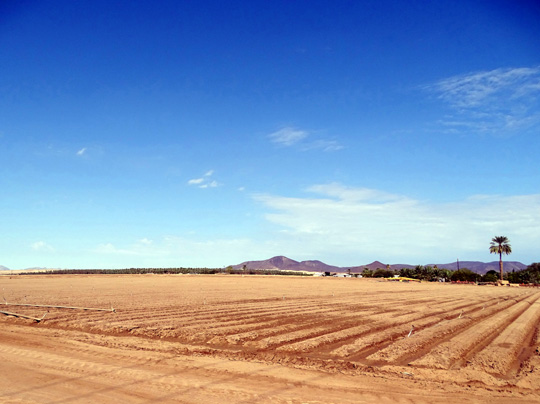
After the dirt was plowed,
trenches and raised rows were made with big farm machinery.
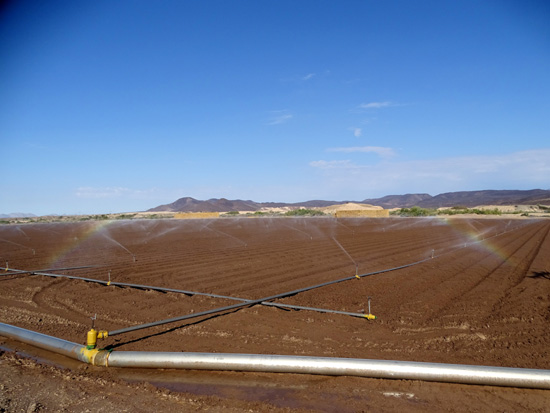
Look hard and you can see little
rainbows in the spray.
This area gets a mere 3 to 3½ inches of
rain per year. Per year, not per rainfall like some places we've
lived and visited. So irrigation is a necessity for the thirsty plants
and fruit trees that grow in the Imperial Valley.
Other than scant rainfall the only
source of water in this region is the lower Colorado River that
separates California and Arizona here.
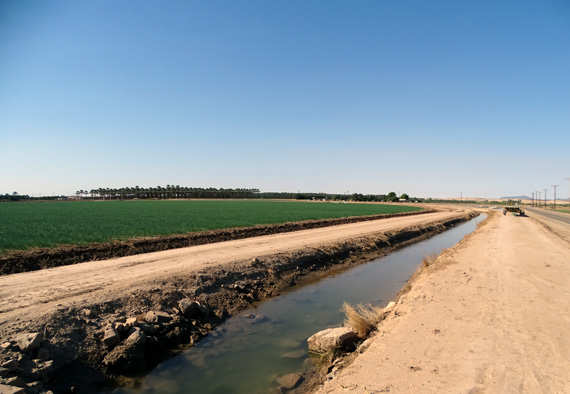
I mentioned in the last entry that the
last free-flowing part of the river is through the Imperial National
Wildlife Refuge.
In the next (approximate) 20 miles of
the river before it reaches Yuma, a tremendous amount of the water is
siphoned off in canals and smaller irrigation ditches like the one in
the photo above to hundreds of thousands of acres of farm land.
It's a wonder any water ever reaches
Yuma -- and I'm guessing there are some serious water rights
issues in this area for such a scarce resource.
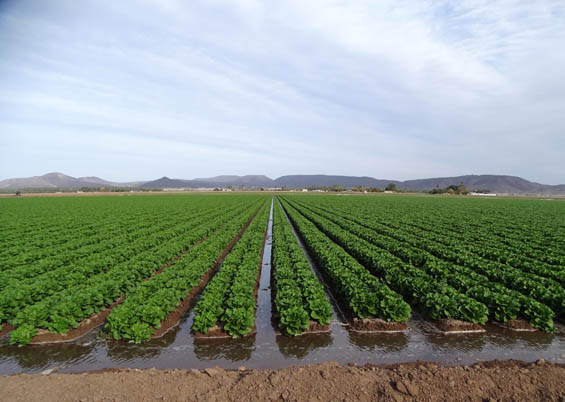
It was fun to watch the young seedlings
get larger and larger, then finally harvested. We passed so many fields
on S24, however, that it was sometimes hard to keep track of what was
where.
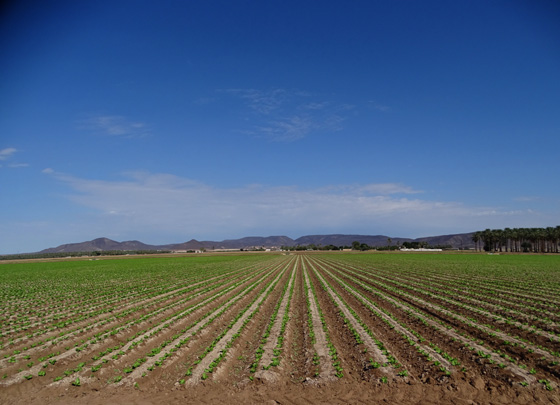
Above and below: small
seedlings like these grow quickly in the valley's
bright sunshine and heat, as long
as they get adequate water.
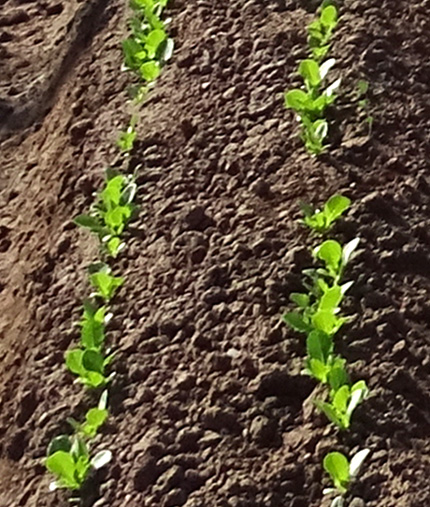
One of the things I miss while not having a house is gardening so
it's fun to watch all this agricultural activity going on.
MEDJOOL DATES: "THE FOOD OF KINGS"
Yuma's booming Medjool date production -- up to 10 million
pounds a year -- rivals that of the Middle East where they
originated. This crop alone is worth about $35 million to the local
economy.
Dates are a nutritious super-food. They are fat-free and high in fiber,
potassium and anti-oxidants. Despite their rich taste they have a low
glycemic level. I used to eat them during long training runs and ultra
marathons for a quick boost of energy. They can be eaten alone or used
in many recipes.
We can see groves of date trees all along S24 on our way to Yuma,
from these newly-planted and wrapped sprigs standing in water . . .
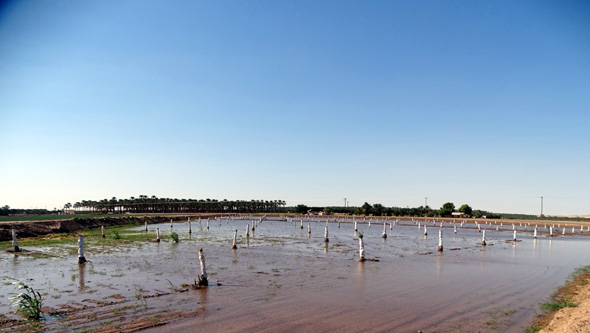
. . . to larger date trees, also sometimes standing in water:
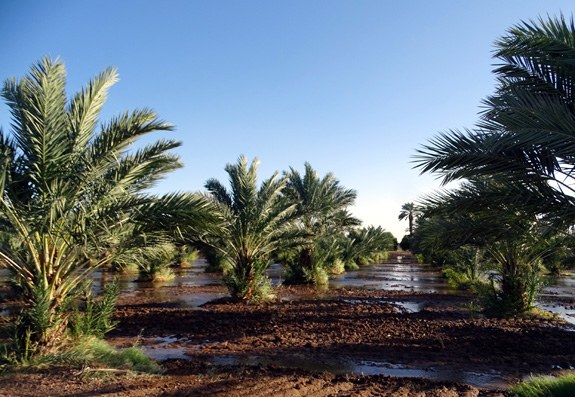
More often when we drove by date groves the ground was dry. They just
need their feet wet periodically.
We learned more about the nutritional value of dates, how they are grown
and harvested, and the history of how this species came to be grown here
during a very interesting free tour we took at Imperial Date Gardens one
day in mid-November.
PERSONAL TOUR OF IMPERIAL DATE GARDENS
During several visits to this date store for their awesome date
shakes I saw their sign advertising free date tours during
November to March on Wednesday mornings at 10:30.
Jim and I showed up on one of the first tours of the season, knowing
they would be busier as more and more snowbirds arrived. To our
surprise, we were the only ones on the tour that day but our tour guide,
Raoul, was most accommodating and gave a great tour. We had the
opportunity to ask a gazillion questions as he showed us many of the
steps involved in growing Medjool date trees and harvesting/processing
the dates.
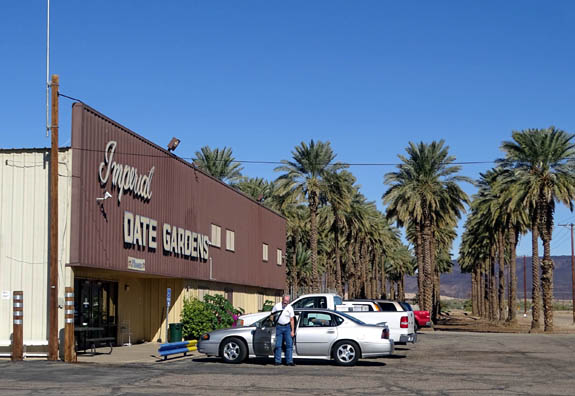
Older date trees can
grow quite tall in this ideal climate.
The history of how dates were introduced to Imperial Valley is
interesting.
Some disease about destroyed the Medjool dates in Morocco
back in the 1940s, I think it was. The father of the current owner of this
company got 11 good female starts and male trees to pollinate them and
propagated them so well that this area produces the most Medjool dates
of any place in the world, even the Middle East.
Raoul has been working as a bookkeeper for the company quite a few years.
He has a bunch of other responsibilities, too, like employee training and
conducting tours during the winter. He seems well-versed in every aspect
of the business.
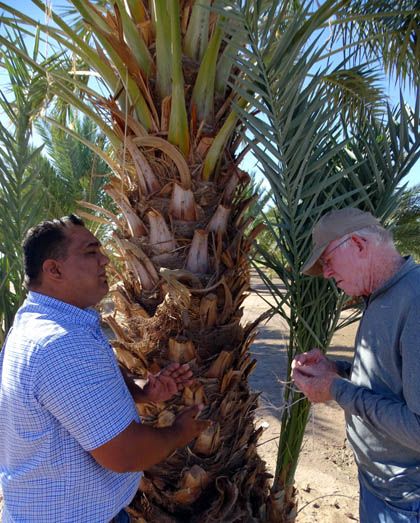
Unlike many of the local farm workers who live across the border in
Mexico (just a few miles south of Yuma) and just come here during the
day for their jobs, Raoul is an American citizen, born and raised here.
He has dual citizenship and recently began living in Algadones, MX. He
drives up here every day, which means going through customs 2x/day, and his kids go to
school here. Although he pays U.S. income taxes he says it's still much cheaper
to work here and live down there.
Raoul began our tour outside in the grove of 12-year-old trees next to the
large building housing the warehouse and store on CA S24.
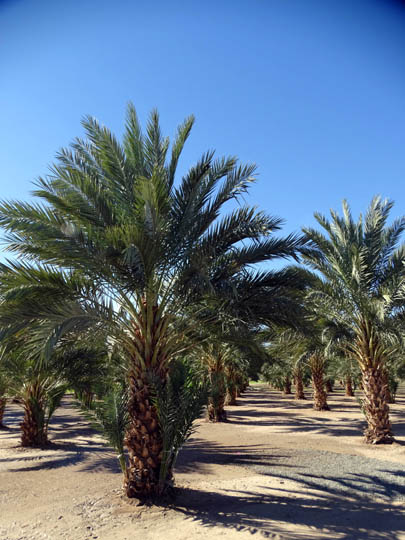
There are several companies involved with the date association in the
Yuma area (Imperial Valley).
Imperial Date Gardens is the largest and oldest of the group, with 3,100
acres of trees nearby in Arizona and California. The store/processing
plant is on the California side of the Colorado River (state border) but
most of the trees are on the Arizona side.
About 25 trees grow on each acre. Their oldest trees were planted in
1972. Raoul showed us how the female trees are trimmed, de-thorned, and
pollinated (in January, which we could see when we were driving by).
After the dates start growing in the spring only the best looking 10%
are allowed to mature. Last year this one company processed over 8
million pounds of dates, ranging in quality from "mixed"
to the best.
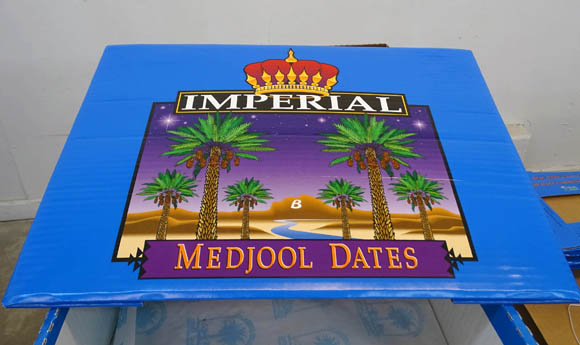
Harvesting and processing the dates is as labor-intensive as doing all
the maintenance necessary on the trees. The harvest peaks in August and
processing peaks in September, when 500+ employees are kept busy at this
one company alone (many fewer work there in the winter).
Raoul showed us the processing plant behind the store for the
dates that Imperial Gardens keeps; over half their crop goes to the
association downtown.
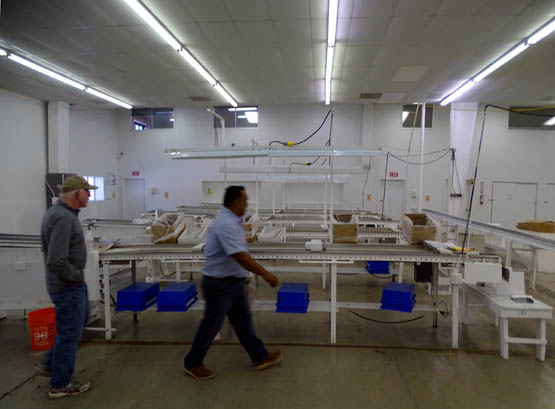
In addition to sorting the dates according to size and quality, they are
cleaned, packed, and most are frozen to retain their moisture and
flavor. They can be frozen and re-frozen with no problem. Dried dates
can also be re-hydrated with little to no loss in quality.
Raoul talked to us for about 40 minutes. It was very interesting -- and
free, except for the date shakes we bought. <grin>
The rest of the
winter we encouraged other
RVers at Yuma Proving Ground to do the tour if they hadn't already. Raoul has the
largest groups in January and February when more people are in the Yuma
area and tour buses stop by.
Next entry: My Name Is Casey -- the RV lifestyle, from
the perspective of a young, exuberant Labrador retriever (Jim helped
Casey write this one)
Happy trails,
Sue
"Runtrails & Company" - Sue Norwood, Jim O'Neil,
Cody the ultra Lab, and Casey-pup
Previous
Next
© 2015 Sue Norwood and Jim O'Neil



















